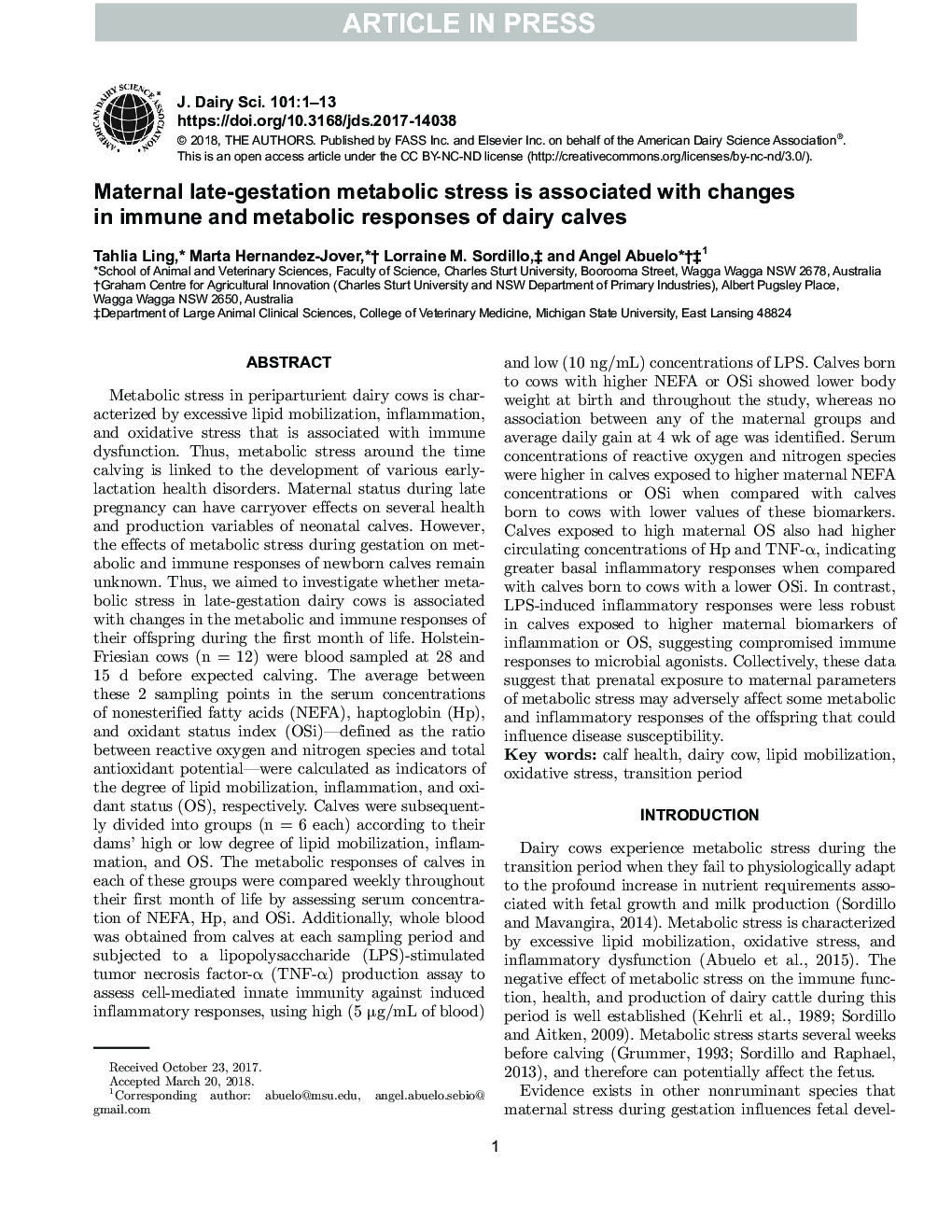| کد مقاله | کد نشریه | سال انتشار | مقاله انگلیسی | نسخه تمام متن |
|---|---|---|---|---|
| 8501113 | 1553838 | 2018 | 13 صفحه PDF | دانلود رایگان |
عنوان انگلیسی مقاله ISI
Maternal late-gestation metabolic stress is associated with changes in immune and metabolic responses of dairy calves
ترجمه فارسی عنوان
استرس متابولیک در دوران بارداری مادر با تغییرات در پاسخ های ایمنی و متابولیکی گوساله های لبنی همراه است
دانلود مقاله + سفارش ترجمه
دانلود مقاله ISI انگلیسی
رایگان برای ایرانیان
کلمات کلیدی
سلامت گوساله، گاو شیری، بسیج لیپید، استرس اکسیداتیو، دوره گذار،
موضوعات مرتبط
علوم زیستی و بیوفناوری
علوم کشاورزی و بیولوژیک
علوم دامی و جانورشناسی
چکیده انگلیسی
Metabolic stress in periparturient dairy cows is characterized by excessive lipid mobilization, inflammation, and oxidative stress that is associated with immune dysfunction. Thus, metabolic stress around the time calving is linked to the development of various early-lactation health disorders. Maternal status during late pregnancy can have carryover effects on several health and production variables of neonatal calves. However, the effects of metabolic stress during gestation on metabolic and immune responses of newborn calves remain unknown. Thus, we aimed to investigate whether metabolic stress in late-gestation dairy cows is associated with changes in the metabolic and immune responses of their offspring during the first month of life. Holstein-Friesian cows (n = 12) were blood sampled at 28 and 15 d before expected calving. The average between these 2 sampling points in the serum concentrations of nonesterified fatty acids (NEFA), haptoglobin (Hp), and oxidant status index (OSi)-defined as the ratio between reactive oxygen and nitrogen species and total antioxidant potential-were calculated as indicators of the degree of lipid mobilization, inflammation, and oxidant status (OS), respectively. Calves were subsequently divided into groups (n = 6 each) according to their dams' high or low degree of lipid mobilization, inflammation, and OS. The metabolic responses of calves in each of these groups were compared weekly throughout their first month of life by assessing serum concentration of NEFA, Hp, and OSi. Additionally, whole blood was obtained from calves at each sampling period and subjected to a lipopolysaccharide (LPS)-stimulated tumor necrosis factor-α (TNF-α) production assay to assess cell-mediated innate immunity against induced inflammatory responses, using high (5 μg/mL of blood) and low (10 ng/mL) concentrations of LPS. Calves born to cows with higher NEFA or OSi showed lower body weight at birth and throughout the study, whereas no association between any of the maternal groups and average daily gain at 4 wk of age was identified. Serum concentrations of reactive oxygen and nitrogen species were higher in calves exposed to higher maternal NEFA concentrations or OSi when compared with calves born to cows with lower values of these biomarkers. Calves exposed to high maternal OS also had higher circulating concentrations of Hp and TNF-α, indicating greater basal inflammatory responses when compared with calves born to cows with a lower OSi. In contrast, LPS-induced inflammatory responses were less robust in calves exposed to higher maternal biomarkers of inflammation or OS, suggesting compromised immune responses to microbial agonists. Collectively, these data suggest that prenatal exposure to maternal parameters of metabolic stress may adversely affect some metabolic and inflammatory responses of the offspring that could influence disease susceptibility.
ناشر
Database: Elsevier - ScienceDirect (ساینس دایرکت)
Journal: Journal of Dairy Science - Volume 101, Issue 7, July 2018, Pages 6568-6580
Journal: Journal of Dairy Science - Volume 101, Issue 7, July 2018, Pages 6568-6580
نویسندگان
Tahlia Ling, Marta Hernandez-Jover, Lorraine M. Sordillo, Angel Abuelo,
